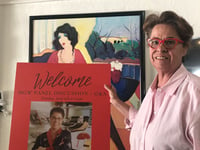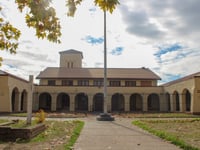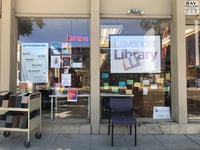In conversations about the history and present of Sacramento’s LGBTQ+ communities, the Lavender Heights district — situated in Midtown — is often the first area to come to mind. With gathering spaces like the Sacramento LGBT Center, formerly the Lambda Center, the Lavender Library and Faces Nightclub in the neighborhood, it’s understandable that it was recognized as the city’s official “gayborhood” in 2015 through the efforts of then-city Councilmember Steve Hansen and the Rainbow Chamber of Commerce.
A rainbow crosswalk bridging 20th and K Streets denotes what was typically considered the Heights’ central point. Lavender street signs posted at area intersections also recognize the Lavender Heights area.
 Andrew Nixon / Capital Public Radio
Andrew Nixon / Capital Public Radio
But LGBTQ+ history has happened all across Sacramento. And now, the city’s preservation staff is leading the LGBTQ+ Experience Project, an effort to create a historic context statement that captures the history of Sacramento’s LGBTQ+ communities: Namely, the structures, buildings and places that have shaped their experiences, both within Lavender Heights and outside of it.
A historic context statement articulates the history of a particular group within an area and facilitates the preservation of important sites to specific communities, and the city of Sacramento isn’t new to this work — in fact, the current project is based on the African American Experience Project the city recently undertook.
Both projects come from “sort of a reorientation in the way that we practice historic preservation, not just in Sacramento, but really, nationwide,” said Sean de Courcy, the city’s preservation director.
“Historic preservation is all about preserving places for people, not just places for the building’s sake, but so that people can enjoy them,” he said. “What we’ve sort of started to shift the focus as a profession … and as a city … is to try to identify places that are important to specific groups.”
And the project could also broaden how community members conceptualize the breadth of LGBTQ+ history throughout Sacramento. Even despite consensus on the neighborhood’s central point, the Heights’ boundaries themselves have been contested, said William Burg, a historian and the president of Preservation Sacramento — reflecting varied experiences with where LGBTQ+ people have found community in Sacramento.
“Saying ‘Oh, this one neighborhood is where everything happened can be a little reductive,’” Burg said. “This is a city-wide historic context. Just as the African American [Experience Project] context wasn’t just about North Sacramento and Oak Park, it was city-wide, [and] so is this survey.”
LGBTQ+ Experience Project aims to commemorate social movements, context, community landmarks
Historic preservation work initially came out of the urban renewal period in the 1960s, when historic buildings were being torn down and people tried to preserve historic architecture, de Courcy said.
“They identified buildings that had sort of a common architectural era and designated them as historic,” he added.
But the trend in historic preservation toward preserving buildings important to people’s history is reflected in the African American Experience Project and now, the LGBTQ+ Experience Project. Because the approaches to preservation have been primarily architecture-centric, de Courcy said the city has a “strong and storied relationship with a very sort of insular group of people in the central city.”
The African American Experience Project pushed city preservation staff to work with people outside the grid and central city, build relationships with a wider array of community members and give people more tools to participate in preserving their community’s history. De Courcy said it was the city’s first effort to “look at a group of people that has a history in Sacramento that hasn’t been the focus of some of the histories that we’ve documented and told as a city.”
“Those stories are not part of our register — we can’t recognize them with plaques or statues and things because we haven’t documented why they’re important,” he said. “Out of that came a historic context statement … it gives a thematic narrative that puts the history of African Americans into several categories and helps us understand the places where maybe a building doesn’t exist anymore.”
The project identified dozens of places worthy of historic designation and preservation, de Courcy added — something he hopes to replicate through the LGBTQ+ Experience Project.
Right now, the project is still in relative infancy. In mid-November, the city approved matching over $26,000 of the $40,000 in federal funding from California’s Historic Preservation Fund granted for the LGBTQ+ Experience Project.
“That $66,000 is just a fraction of the overall, you know, support and commitment that that the city brings, and then all the volunteer partners, bring to bear,” de Courcy added.
The city funds will go toward paying a consultant to help the two-person city preservation staff. The city is currently reviewing consultant proposals to decide which one has the approach most aligned with preservation staff’s project goals. City preservation staff, including the hired consultant, will pore through archives, libraries and research, in conjunction with oral history interviews that project staff will conduct with community members.
All that work will run through the end of 2024 and go toward creating the historic context statement.
Burg said he expects Preservation Sacramento to play a similar supportive role to the city’s work as they did during the African American Experience Project — the organization provided $10,000 in stipends to pay people for their time and provide refreshments for city events where community members gave their oral histories.
And de Courcy said he’s hoping to carry forward the ethos preservation staff had for the African American Experience Project: “We’re going to meet community members where they are.”
He said these projects have come about so the city can move proactively, instead of a developer coming in with a proposal that LGBTQ+ community members oppose because it could tear down a historic building or structure.
“If we don’t do the work upfront to document and understand this history, then that community is being done a disservice,” he said. “Because they’re reacting to a project and they’re having to come tell us and explain to us as a city or whoever’s approving this project why that place is important and should be preserved.”
And while a historic context statement doesn’t immediately enshrine places in the Sacramento Register of Historic and Cultural Resources register, it does lay the groundwork for that preservation to happen. It also creates the potential for them to be listed in the National Register of Historic Places, which can open up other incentives for money to be poured back into the community like the Federal Historic Rehabilitation Tax Credit.
“In terms of historic preservation, it’s generally … related to buildings, and so we recognize and protect that history by identifying places where things happened,” Burg said. “We commemorate the history, it’s documented, the information is there, but the place also has a measure of protection.”
He added that identifying historic buildings isn’t arbitrary: They need to be old enough, within the minimum threshold of 50 years. They need to have historic integrity, resembling what they looked like during the historic period they’re being remembered for. And they need to have an identified historic context and some connection to a place’s past, whether through architecture, frequent community usage or being the site of an important event — that’s where developing a historic context statement comes in.
“Generally, the newest buildings you’d be looking at that are potentially historic today would be ones from the early ‘70s,” Burg said. “Some of the seminal turning points in LGBTQ+ of the 20th century, Stonewall, and the Black Cat Cafe … and the early ‘70s were the beginnings of the more formalized gay rights movement as well as the women’s liberation movement. There was also often some common ground there in terms of the places and spaces used for organizing.”
Still depths of Sacramento LGBTQ+ history to catalog, explore
Sacramento State alum and gay rights lobbyist George Raya, who was born in the city and raised in Wheatland, emphasized that Sacramento has a lot of gay history — ”modern history and older history,” he said.
In recent years, some Sacramento-area groups have been directing more energy toward expanding archives of and sharing that history. Preservation Sacramento has led walking tours of Lavender Heights. The Center for Sacramento History has been compiling a complete archive of Mom…Guess What!, the city’s longest-running LGBTQ+ newspaper, and hosted an event this summer to reflect on its impact. And the Lavender Library has been creating a grassroots archive of local queer and trans Sacramentan oral histories.
Raya himself has been part of Sacramento’s LGBTQ+ community milestones. His lobbying work at the Capitol and at the White House helped lead to the decriminalization of homosexuality. And during his time as a college student in the early ‘70s, where as the president and founder of the Society for Homosexual Freedom, he won a landmark court battle setting a precedent for LGBTQ+ student organizing and activism on university campuses nationwide.
“When we had our first organizational meeting, which was at a professor’s home, every time there was a knock on their door, we [looked] first because we didn’t know if it was the police coming or if it was another person coming to attend the meeting,” Raya recalled on CapRadio’s Insight in 2019. “Because at that point it was illegal [to be openly LGBTQ+].”
And the stigma associated with homosexuality and transgender communities at the time, Burg said, means “it’s very difficult to find a lot of these subjects — they’re not easy to find in existing history books.”
For example, many gay bars in the ‘60s were across the river in West Sacramento, Raya said, because of the then-county sheriff, “a real redneck type … he thought sin should be on the other side of the river.”
But there was one gay bar — Topper Club — that persisted, Raya said: “On T Street … where Hyatt Regency Hotel is nowadays.”
Even though Burg himself has led Lavender Heights walking tours, he said the history is “understudied” and “almost like hidden, invisible … if you go back to the ‘60s or late ‘50s, in some cases, it just becomes vanishingly difficult [to find historic places].”
Still, that didn’t mean things were completely grim. Among the things Raya hopes is captured in the historic context statement is his own family stories.
“I’m the fourth in my family to come out,” he said. “I came out in 1969. And I had three older cousins — two lesbians and a drag queen cousin — who came out before me. And they were coming to family reunions, Thanksgiving reunions at my grandmother’s restaurant in the late ‘50s, and were totally accepted by the family. … Normally, you didn’t see that. But in our family, it was happening.”
And while demolition of important buildings to marginalized communities in Sacramento is unfortunately very common — take the multicultural West End, which Burg said has “almost nothing left” — “even when people are displaced when buildings are demolished or communities are lost, the people don’t disappear, they pick up and they start somewhere else.”
“Those are the places that we look for the evidence, as well as the background evidence,” Burg said.
That means the LGBTQ+ Experience Project and the historic context statement it aims to produce can result in recognition of sites like the demolished Topper and former bookstores The Open Book — frequented by Lavender Library founder Gail Lang — and lesbian-owned Lioness Books.
And, he added, it can also highlight places like the original site of the Sacramento LGBT Center, formerly the Lambda Center, at 1927 L Street — a building funded in part through an unwilling contribution from Rev. Jerry Faldwell. Or the buildings from the former state fairgrounds where Americans for Responsible Citizenship, a homophile organization (as early gay and lesbian rights organizations were called), staged a public, large-scale gay rights protest by handing out gay rights pamphlets in 1966 after being denied a fair booth. And the “pink fairy palace,” as it was known to early gay rights activists, on 22nd and P Streets, which was formerly painted a lavender-pink color.
“We protect historic buildings because they matter to us,” Burg said. “Making that story more inclusive … hopefully it helps mend some fences and make bonds and let people within these communities who often do feel very much marginalized and not connected to the history, that there’s a greater stream there and there’s people who care about it a great deal.”
And while there’s a large survey component of the project focused on assessing historic sites in Lavender Heights, de Courcy said they’re also identifying places outside the central city — where their initial research to formulate the grant proposal for the project turned up several places.
“A lot of these places — especially when you talk about, like, day entertainment and nightclubs and bars, these places had to be in places where there wasn’t a lot of attention,” he said. “There’s actually oftentimes some overlap with the African American community, in terms of, they [these places] were in North Sacramento or South Sacramento.”
De Courcy has already gotten questions about capturing Chinese, Hmong, Laotian and Mexican experiences, among others, in similar projects. And he said the city hopes to continue undertaking similar projects for other communities in Sacramento as long as they can continue to secure funding.
“If we don’t tell the stories of those places, then we don’t tell the story of the people who value those places,” de Courcy added.
City staff will be providing updates on the LGBTQ+ Experience Project, including public meeting dates and ways to contribute, through their email list. Signing up for email will also notify you when the city opens its online portal for folks to contribute documents to their archive.
CapRadio provides a trusted source of news because of you. As a nonprofit organization, donations from people like you sustain the journalism that allows us to discover stories that are important to our audience. If you believe in what we do and support our mission, please donate today.






